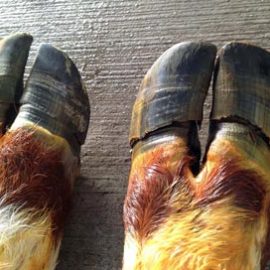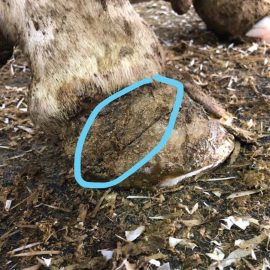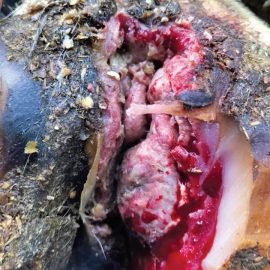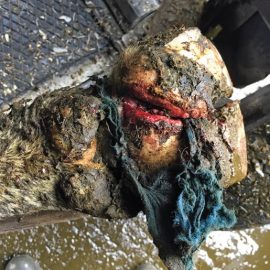The World Wide Web And Its Power!!
By John Dawson
The WWW was not even a thought when I started treating lame cows. We contacted customers via landline telephones and pagers. Now at the speed of lightning, the ‘World of Hoof Trimmers’ Facebook page reaches over 4000 trimmers and related parties, dealing with cattle lameness throughout the world. One push of the button and your message reaches all corners of the world.
The WWW allows the quick dissemination of information; trimming tips, advice, great pictures of trimmer’s work, workshops, the occasional humorous post and a plethora of questions asked. Questions are posed for new problems encountered during the hard working day. The quest for knowledge, the cure for the unknown, help for the new starter, they all bring passionate answers.
It is always interesting to read some trimmer’s thoughts and personal ideas as they answer the technical questions which appear. There are some very vehemently, confident opinions given. All very honourably offered, to give the asking body a helping hand. However, sometimes, the answers and opinions given can be misleading to the trimmer who has asked the question.
I hope you don’t mind me taking my own liberty to offer answers which are based on scientific reasoning, to some of these questions and downloaded images.


Horizontal/Stress Wall Cracks
My first image is of Horizontal Cracking of the hoof. How, or what causes these was the question. (Fig 1. horizontal stress line).
These are caused by a severe bout of inflammation of the corium which causes a complete cessation of horn formation. This complete cessation, which can be quite momentary, causes complete interruption to horn formation and a break in its production. This causes a weak horizontal line in the horn at the time of the inflammatory episode. As time passes and the horn grows out, progressing down the wall, the outward force on the hoof wall increases as it impacts on the floor. The increasing outward force eventually cracks the weak line and the wall becomes 2 pieces. The timing of the inflammatory episode can be estimated very accurately by measuring the distance from the coronary band. Horn grows down the wall at approximately 1 cm per month. It is usually about half way down the wall when it usually becomes a crack and first demonstrates sever pain. This relates to a stressful, inflammatory episode approximately 4 months previously. The inflammatory episode has numerous causes. These include, nutritional imbalances (barley poisoning), toxic infection (Mastitis, endometritis), acute laminitis (toxins, poisons) and traumatic inflammatory episodes. It most often occurs on more than one foot and very often on all 4 hooves and all 8 claws. (Fig 2. 2 of 4 hooves affected in one animal).
It has very serious consequences on lameness. As months pass and the cracks grow out towards the toe and heel the angular force of walking impact bends the horn on the lower part of the hoof wall outwards prizing it away from the coronary band. This experience is similar to you trying to pull your nail off your finger. If you bear this analogy in mind you can understand how painful a condition it can be and if the horizontal cracks are present on all 4 hooves the animal has no good claws on which to bear weight.
Treatment is very difficult if the cracking is present on all hooves and a lot of TLC on very soft bedding combined with good anti-inflammatory treatment is required for several months until the cracks grow out and a good layer of healthy horn is present. Continual therapeutic trimming, removing loose horn to alleviate the outward motion of the wall is required. If there are some claws which are unaffected blocks can be applied on the good claws to relieve the pressure and pain on the affected claw. If no good claws are present applying a layer of glue on the outer wall of the claw, completely covering the wall, can help stabilise the bottom part of the hoof wall and stop it bending outs and pulling at the corium underneath.


Complicated Foul
The second image depicts a deep interdigital infection described as and treated as Digital Dermatitis (DD). The author of the picture describes it as being taken a week after being treated by wrapping with Salicylic acid. With no improvement. (Fig 3 Posted as DD and been treated 1 week before with wrap and salicylic acid powder).
The picture does display some signs of DD especially at the edges of the wound which has keratinised hairy projections, a sign of DD. However, the depth of the lesion in the interdigital area is not typical of DD. The interdigital lesion is typical of a complicated foul with infection penetrating deep into the inter-digital space. Fouls are infections of the interdigital area, the infection penetrating a wound of the skin. The wound in this case was probably due to the DD damage to the skin. Treatment of this lesion will be very difficult, as the author is finding. It has large areas of granulation tissue indicating a long standing lesion. It is so deep seated and indolent that it will require intensive TLC and treatment beyond the scope of the UK trimmer. Antibiotics and possibly digit amputation will be the only remedy if the cow is not to be culled.


To finish with I will pose the question – Bandage or No Bandage.
We were conducting an examination day on a new farm one day when a cow was presented to an examinee lame in the front left foot. After lifting the foot it was obvious what was causing the lameness. (Fig 4. Bandage been left on too long. Very deep wound with severe infection). The cow had been trimmed and treated some time ago. Treatment had included the application of a bandage. The picture speak for themselves but it is a severe example of the effect of applying a bandage without the aftercare required to manage it’s removal/reapplication/ monitoring.
Bandages are greatly overused and the consequences can be devastating. Many DD treatment comparisons indicate good cure rates without applying too many bandages. It is advisable to only apply bandages to severe lesions and ensure their correct management and removal. We should all think before applying them.


